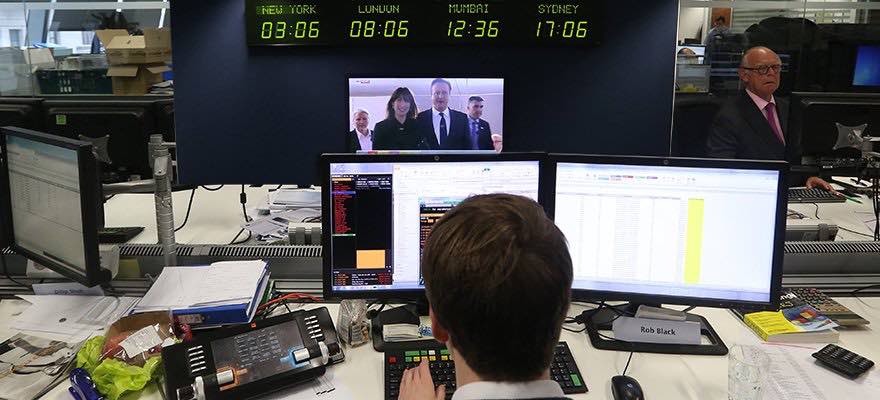This guest article was written by Nikolai Kuznetsov from NikolaiKnows.com.
With more millennials getting into the financial markets to invest their savings or surplus regular incomes, technology is taking center stage and redefining how trading is being done in the Forex
Forex
Foreign exchange or forex is the act of converting one nation’s currency into another nation’s currency (that possesses a different currency); for example, the converting of British Pounds into US Dollars, and vice versa. The exchange of currencies can be done over a physical counter, such as at a Bureau de Change, or over the internet via broker platforms, where currency speculation takes place, known as forex trading.The foreign exchange market, by its very nature, is the world’s largest tradi
Foreign exchange or forex is the act of converting one nation’s currency into another nation’s currency (that possesses a different currency); for example, the converting of British Pounds into US Dollars, and vice versa. The exchange of currencies can be done over a physical counter, such as at a Bureau de Change, or over the internet via broker platforms, where currency speculation takes place, known as forex trading.The foreign exchange market, by its very nature, is the world’s largest tradi
Read this Term markets. Many brokerages are now coming up with innovative trading solutions to suit this category of traders, top among them being social trading and algorithmic trading.
Social trading or what is also referred to as mirror trading is a trading solution whereby a small business or a new trader places their trading orders based on what other traders within the same platform are doing. Normally the expert and experienced traders in the platform will be used as benchmarks by smaller and newer traders, who will try to mirror his or her trading moves and then replicate the same in their own trading.
This saves the new traders the time of engaging in extensive market research and analysis before starting to trade.
On the other hand, algorithmic trading is a process whereby a computer is pre-programmed with conditions upon which it should automatically initiate a trade. In this case the trader does not have to keep checking what other traders are doing in the market before placing their trading orders. With algorithmic trading, the computer will automatically get market signals when certain price limits are hit and trigger a buy or sell order based on how it was pre-programmed by the trader.
Pros and Cons of Social Trading
By using social trading solutions, a new trader getting into the forex market for the first time or a small trader who does not want to risk all his money will find it easy to trade by following experienced market experts. This reduces the barrier to entry into the market caused by lack of prior experience in Forex Trading
Forex Trading
Forex trading is the buying and selling of foreign currencies with the aim of generating a profit. The value of currencies, especially floating currencies, fluctuate to varying degrees. This constant volatility of exchange rates opens the door for speculators to invest in a certain currency against another. The Forex market is the world’s biggest and most liquid market, with over $5 billion turnover every single day, with the market being open 24 hours a day, 5 days a week.It goes without saying
Forex trading is the buying and selling of foreign currencies with the aim of generating a profit. The value of currencies, especially floating currencies, fluctuate to varying degrees. This constant volatility of exchange rates opens the door for speculators to invest in a certain currency against another. The Forex market is the world’s biggest and most liquid market, with over $5 billion turnover every single day, with the market being open 24 hours a day, 5 days a week.It goes without saying
Read this Term. In addition, those individuals using mirror trading tend to gain more confidence to invest more money in their accounts and to trade much more often since their confidence level is higher as they are copying the trading patterns from an expert. It is estimated that traders who practice copy trading end up making profits 311% higher than their peers who do not use it.
Brokers also benefit when traders start using social trading solutions. Research shows that a broker is able to increase the lifespan of a trade by about 14% when applying copy trading solutions, which translates to approximately a whole month. This is coupled with an increase in the number of positions a trader holds by about 64% and a rise in the volumes traded in each account by about 55%.
The increase in frequency, volumes and trading periods eventually results in increased profits for the broker too.
Social trading does not always reward the novice traders as much as they expect.
This is due to the fact that experienced traders always engage in thorough research and market analysis that builds their market leadership. In such a case it is unlikely that the best traders will easily reveal their trading strategies for free to followers without charging a fee; hence new traders might end up following and copying average traders who might lead them to huge losses as they follow his free trading advice and strategies.
For brokers, a consistent following of particular traders who might not necessarily be the best might result to lower returns in the long-run as traders become less exposed to new and advanced trading strategies in a dynamic market. This might result in some traders leaving from their platforms or a reduction in volumes and frequency of trading, thus reducing the broker’s profit margins.
The copy trading environment now includes a range of autotrading platforms, most involving some form of signal auto, semi-automatic and manual trading where the new trader can copy or follow the expert trader deciding whether his trades be implemented on an automatic basis, semi-automatic basis or on a manual review basis.
Pros and Cons of Algorithmic Trading
Algorithmic trading also has its unique benefits to traders. First it saves the trader the time needed to keep tracking market price movements physically. In addition, the trader gets the best execution of trades in real time - immediately as market signals change and get to the pre-programmed levels. This enables the trader to get the best market prices and reduce the bias in decision making when trading that can arise from human emotions.
There is also the benefit of reduced trading errors and reduced costs of trading due to automation of most of the trading decisions.
For the brokers, algorithmic trading provides a more organized and coordinated approach to trading as compared to the traditional method where trading was fully based on the trader’s instincts and intuition. It also enables the broker to plan their trading strategies way in advance and before different market scenarios arise, thus enabling them to execute their trades swiftly when the predicted market conditions arise without being caught unaware.
For long term investors and the buy side brokers who move volumes in the market, using algorithmic trading helps them to keep acquiring additional assets in a gradual and systematic way without having to influence market prices.
The shortfalls of algo trading are based on its own benefit of using technology to seamlessly execute your trades. Once programmed, your trading system will automatically make trades, and if something goes wrong in the programming it might end up making huge losses before it is detected or corrected.
To the brokers, an algo trading system requires high investment in resources and technical expertise in specialized programmers. In addition, cyber security issues come as a challenge since the system needs to be secured against hackers and other intruders with ill intentions.
In the recent past, fintech experts have been developing more complex trading solutions that incorporate artificial intelligence and big data to algorithmic trading. This is meant to address the short-coming of algo trading whereby it only used to rely on the pre-programmed conditions to execute trades. With the integration of artificial intelligence and big data, different trading strategies in the market by different traders can be incorporated by the computer, hence the final trading decision will be based both on the pre-conditions in the algorithm and, at the same time, mirror the trends in the market from other trader’s strategies.
This, therefore, means that some elements of copy trading will be used in algo trading and hence narrowing the gap between the two automated trading solutions.
This guest article was written by Nikolai Kuznetsov from NikolaiKnows.com.
With more millennials getting into the financial markets to invest their savings or surplus regular incomes, technology is taking center stage and redefining how trading is being done in the Forex
Forex
Foreign exchange or forex is the act of converting one nation’s currency into another nation’s currency (that possesses a different currency); for example, the converting of British Pounds into US Dollars, and vice versa. The exchange of currencies can be done over a physical counter, such as at a Bureau de Change, or over the internet via broker platforms, where currency speculation takes place, known as forex trading.The foreign exchange market, by its very nature, is the world’s largest tradi
Foreign exchange or forex is the act of converting one nation’s currency into another nation’s currency (that possesses a different currency); for example, the converting of British Pounds into US Dollars, and vice versa. The exchange of currencies can be done over a physical counter, such as at a Bureau de Change, or over the internet via broker platforms, where currency speculation takes place, known as forex trading.The foreign exchange market, by its very nature, is the world’s largest tradi
Read this Term markets. Many brokerages are now coming up with innovative trading solutions to suit this category of traders, top among them being social trading and algorithmic trading.
Social trading or what is also referred to as mirror trading is a trading solution whereby a small business or a new trader places their trading orders based on what other traders within the same platform are doing. Normally the expert and experienced traders in the platform will be used as benchmarks by smaller and newer traders, who will try to mirror his or her trading moves and then replicate the same in their own trading.
This saves the new traders the time of engaging in extensive market research and analysis before starting to trade.
On the other hand, algorithmic trading is a process whereby a computer is pre-programmed with conditions upon which it should automatically initiate a trade. In this case the trader does not have to keep checking what other traders are doing in the market before placing their trading orders. With algorithmic trading, the computer will automatically get market signals when certain price limits are hit and trigger a buy or sell order based on how it was pre-programmed by the trader.
Pros and Cons of Social Trading
By using social trading solutions, a new trader getting into the forex market for the first time or a small trader who does not want to risk all his money will find it easy to trade by following experienced market experts. This reduces the barrier to entry into the market caused by lack of prior experience in Forex Trading
Forex Trading
Forex trading is the buying and selling of foreign currencies with the aim of generating a profit. The value of currencies, especially floating currencies, fluctuate to varying degrees. This constant volatility of exchange rates opens the door for speculators to invest in a certain currency against another. The Forex market is the world’s biggest and most liquid market, with over $5 billion turnover every single day, with the market being open 24 hours a day, 5 days a week.It goes without saying
Forex trading is the buying and selling of foreign currencies with the aim of generating a profit. The value of currencies, especially floating currencies, fluctuate to varying degrees. This constant volatility of exchange rates opens the door for speculators to invest in a certain currency against another. The Forex market is the world’s biggest and most liquid market, with over $5 billion turnover every single day, with the market being open 24 hours a day, 5 days a week.It goes without saying
Read this Term. In addition, those individuals using mirror trading tend to gain more confidence to invest more money in their accounts and to trade much more often since their confidence level is higher as they are copying the trading patterns from an expert. It is estimated that traders who practice copy trading end up making profits 311% higher than their peers who do not use it.
Brokers also benefit when traders start using social trading solutions. Research shows that a broker is able to increase the lifespan of a trade by about 14% when applying copy trading solutions, which translates to approximately a whole month. This is coupled with an increase in the number of positions a trader holds by about 64% and a rise in the volumes traded in each account by about 55%.
The increase in frequency, volumes and trading periods eventually results in increased profits for the broker too.
Social trading does not always reward the novice traders as much as they expect.
This is due to the fact that experienced traders always engage in thorough research and market analysis that builds their market leadership. In such a case it is unlikely that the best traders will easily reveal their trading strategies for free to followers without charging a fee; hence new traders might end up following and copying average traders who might lead them to huge losses as they follow his free trading advice and strategies.
For brokers, a consistent following of particular traders who might not necessarily be the best might result to lower returns in the long-run as traders become less exposed to new and advanced trading strategies in a dynamic market. This might result in some traders leaving from their platforms or a reduction in volumes and frequency of trading, thus reducing the broker’s profit margins.
The copy trading environment now includes a range of autotrading platforms, most involving some form of signal auto, semi-automatic and manual trading where the new trader can copy or follow the expert trader deciding whether his trades be implemented on an automatic basis, semi-automatic basis or on a manual review basis.
Pros and Cons of Algorithmic Trading
Algorithmic trading also has its unique benefits to traders. First it saves the trader the time needed to keep tracking market price movements physically. In addition, the trader gets the best execution of trades in real time - immediately as market signals change and get to the pre-programmed levels. This enables the trader to get the best market prices and reduce the bias in decision making when trading that can arise from human emotions.
There is also the benefit of reduced trading errors and reduced costs of trading due to automation of most of the trading decisions.
For the brokers, algorithmic trading provides a more organized and coordinated approach to trading as compared to the traditional method where trading was fully based on the trader’s instincts and intuition. It also enables the broker to plan their trading strategies way in advance and before different market scenarios arise, thus enabling them to execute their trades swiftly when the predicted market conditions arise without being caught unaware.
For long term investors and the buy side brokers who move volumes in the market, using algorithmic trading helps them to keep acquiring additional assets in a gradual and systematic way without having to influence market prices.
The shortfalls of algo trading are based on its own benefit of using technology to seamlessly execute your trades. Once programmed, your trading system will automatically make trades, and if something goes wrong in the programming it might end up making huge losses before it is detected or corrected.
To the brokers, an algo trading system requires high investment in resources and technical expertise in specialized programmers. In addition, cyber security issues come as a challenge since the system needs to be secured against hackers and other intruders with ill intentions.
In the recent past, fintech experts have been developing more complex trading solutions that incorporate artificial intelligence and big data to algorithmic trading. This is meant to address the short-coming of algo trading whereby it only used to rely on the pre-programmed conditions to execute trades. With the integration of artificial intelligence and big data, different trading strategies in the market by different traders can be incorporated by the computer, hence the final trading decision will be based both on the pre-conditions in the algorithm and, at the same time, mirror the trends in the market from other trader’s strategies.
This, therefore, means that some elements of copy trading will be used in algo trading and hence narrowing the gap between the two automated trading solutions.






















